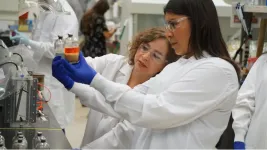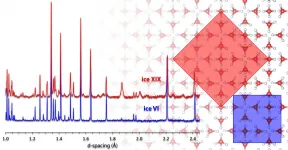(Press-News.org) Ancient alchemists dreamed of transforming base materials like lead into gold and other valuable commodities. While such efforts generally came to naught, researchers today are having some success in extracting a variety of useful products like aviation fuels, lubricants, solvents, food additives and plastics from organic waste.
The trick is accomplished with the aid of specialized bacteria, whose metabolic activities can convert simpler chemicals into useful products through a microbial growth process knows as chain elongation.
Anca Delgado, a researcher in the Biodesign Swette Center for Environmental Biotechnology at Arizona State University, has been exploring the phenomenon. In a new study, she describes for the first time how the chain elongation processes are carried out by microorganisms under normal conditions in soil.
The work promises to shed new light on these poorly understood processes in nature, allowing researchers to better leverage them to convert organic sources like food waste into valuable products. Such techniques offer a double benefit to society, minimizing or eliminating environmental waste/contaminants while producing biochemicals or biofuels and other important resources, through green chemistry. The work will also help researchers expand their knowledge of microbial ecology.
"We observed that different soil types sampled from 1.5 m or less below ground surface harbor a readily active potential for chain elongation of acetate and ethanol," Delgado says. " When fed acetate and ethanol, soil microcosms produced butyrate and hexanoate in just a few days and chain elongation became the main metabolism occurring in these samples."
Delgado is joined by ASU colleagues Sayalee Joshi, Aide Robles, and Samuel Aguiar.
Their research findings appear in the current issue of the International Society of Microbial Ecology (ISME) journal.
Energy from waste
The idea of converting organic residual streams like food waste to fuels and useful compounds has been steadily gaining ground, driven by advancing technologies as well as the rapidly growing global need for clean energy sources and pollution reduction. Such processes can help society form so-called circular economies, in which unwanted waste streams are continually converted into energy sources and other useful commodities.
Organic waste sources hold enormous potential as an alternative resource for producing high-value fuels and chemicals because they are renewable and because they do not compete with the human food chain, (as some existing biofuels like corn ethanol do).
One source for these useful transformations is organic food waste, a staggering amount of which is produced annually. Driven by rising global populations, the accumulation of food waste has become a critical problem, due to associated health and environmental hazards.
Food waste is discharged from a variety of sources, including food processing industries, households, and the hospitality sector. According to the United Nations Food and Agriculture organization, a staggering 1.3 billion tons of food are lost to the food chain, and the amount is on a rapid rise.
From environmental threat to opportunity
In addition to the squandering of food and land resources, food waste contributes a hefty burden to the environment in terms of carbon footprint, increasing greenhouse gas emissions and liberating an estimated 3.3 billion tons of CO2 into the atmosphere per year. Researchers hope to convert these waste residues into useful products and purify them in an efficient manner.
One of the most innovative and eco-friendly means of dealing with all of this organic waste is through anaerobic digestion, which also holds the promise of expanding the world's energy supply. A promising emergent technology employing anaerobic digestion is known as microbial chain elongation, a metabolic process used by anaerobic microorganisms to grow and acquire energy. They do this by combining carboxylate chemicals like acetate (C2), with more reduced compounds, such as ethanol (C2), to produce longer-chain carboxylates (typically C4-C8).
This biotechnological process converts volatile fatty acids (VFAs) and an electron donor, typically, ethanol, into more valuable medium chain fatty acids (MCFAs), which are the precursors needed to produce biofuels and other useful chemicals. Initial waste sources are processed through chain-elongation, which involves the cyclic addition of carbon units, thereby converting municipal solid waste, agriculture waste, syngas, etc., into the high-value, medium-chain carboxylates like hexanoate (C6) and octanoate (C8).
The conversion of VFAs into MCFAs with ethanol as electron donor is accomplished by chain elongating microorganisms, particularly, a bacterium known as Clostridium kluyveri. C. kluyveri (and closely related bacterial strains) accomplish their chain-elongation feats through a process known as the reverse β-oxidative pathway. As the name suggests, this pathway is the opposite of metabolic pathway organisms use to break down fatty acids derived from foods.
In recent years, researchers have explored β-oxidation pathways as well as developing the means to reverse these pathways in order to produce chemicals and polymer building blocks, using industrially relevant microorganisms.
Reactions under our feet
Chain elongation has hence proven an effective means of producing valuable chemicals in laboratory bioreactors, though the process is presumed to occur naturally in soils as well. It turns out that anaerobic soils and sediments are often rich in the same kinds of biodegradable organic compounds found in municipal or agriculture waste streams and therefore, a natural source of chain elongation.
Using soil samples from four various US locations, the current study examines the extent of natural chain elongation and how these processes vary according to the particular biogeochemical characteristics of soil composition. The research was designed to gauge the prevalence of chain elongation in anaerobic soil microorganisms and its possible role in microbial ecology.
The results demonstrate the potential for chain elongation activities involving acetate and ethanol, which are typical metabolites found in soils as a result of organic compound fermentation. The study measured high enrichment rates in microorganisms similar to C. kluyveri under chain elongating conditions, which were found to vary with soil type.
The findings shed new light on this intriguing aspect of microbial ecology and may provide helpful clues for future efforts using microorganisms to process waste streams into a range of beneficial chemicals and other products.
As Delgado notes, "on the fundamental side, results from this study are paving the way for investigations on the activity of chain elongation in situ. On the biotechnology side, this work shows that soils can be excellent sources of chain-elongating microorganisms for bioreactors focused on production of the specialty chemicals, hexanoate and octanoate."
INFORMATION:
EUGENE, Ore. -- Feb. 18, 2021 -- An abnormal suppression of the immune system linked to the onset of numerous diseases has been associated with poor functional regeneration of traumatic bone injuries.
Levels of immune cells and proteins circulating in the blood following traumatic injury combined with advanced data analytics could predict whether patients are likely to respond to treatment, said Robert Guldberg, executive director of the Phil and Penny Knight Campus for Accelerating Scientific Impact.
The project -- detailed in a paper published online ahead of print in the Proceedings of the National Academy of Sciences -- identified ...
WASHINGTON--A potentially dangerous side effect of testosterone therapy for transgender men is an increase in red blood cells that can raise the risk of blood clots, heart attack or stroke, according to a new study published in the Endocrine Society's Journal of Clinical Endocrinology & Metabolism.
Gender diverse people make up an estimated 0.6% of the U.S. population and are defined as having gender identity that is not aligned with their sex recorded at birth. Transgender men often undergo testosterone therapy as part of their gender-affirming treatment. Erythrocytosis, a condition where your body makes too many red blood cells, is a common side effect of testosterone therapy that can increase the risk of blood clots, heart attack or stroke.
"Erythrocytosis is common ...
Despite being one of the world's most charismatic species, tigers face uncertain futures primarily due to habitat fragmentation, human-wildlife conflict and poaching. As global tiger populations decline, so does their genetic diversity. But until now it's been unclear how the animals' dwindling numbers are affecting them at the genetic level.
To find out, researchers at Stanford University, the National Centre for Biological Sciences, India, and various zoological parks and NGOs sequenced 65 genomes from four of the surviving tiger subspecies. Their findings confirmed that strong genetic differences exist between different tiger subspecies but showed, surprisingly, that these differences emerged relatively recently, ...
Transit-oriented development--which concentrates high-density housing, commercial activities and public spaces around a rapid transit station--can both be a boon and a bane for communities, suggests a new UBC study.
"Transit-oriented development (TOD) can reduce traffic congestion and air pollution, encourage active mobility, and revitalize a neighbourhood," explains study author Craig E. Jones, a PhD candidate in geography and the research coordinator for the Housing Research Collaborative at UBC's faculty of applied science.
"However, it can also cause gentrification through the demolition of affordable rental housing. It can tailor the area towards condo ...
PHOENIX, Ariz. and DUARTE, Calif. -- Feb. 17, 2021 -- Urinalysis has long been a staple of physical exams to detect and manage a number of diseases and disorders, but not cancer. What if it were that easy, though, and cancer was detected in its very earliest stages when the disease responds more favorably to treatment and improved outcomes are more likely?
That was the question posed by scientists at the Translational Genomics Research Institute (TGen), an affiliate of City of Hope, who have found a way of zeroing in on early-stage cancer by analyzing short strands of cell-free DNA in urine. Their study's findings were published today in the scientific journal Science ...
Severe forms of malaria such as Plasmodium falciparum may be deadly even after treatment with current parasite-killing drugs. This is due to persistent cyto-adhesion of infected erythrocytes even though existing parasites within the red blood cells are dead. As vaccines for malaria have proved less than moderately effective, and to treat these severe cases of P. falciparum malaria, new avenues are urgently needed. Latest estimates indicate that more than 500 million cases of malaria and more than 400,000 deaths are reported worldwide each year. Anti-adhesion drugs may hold the key to significantly improving survival rates.
Using venom from the Conus nux, a species of sea snail, a first-of-its-kind study ...
Extending the symptoms that trigger a PCR test for COVID-19 could help detect around a third more cases of the disease.
New research led by researchers at King's College London and published in the Journal of Infection suggests that restricting testing to the 'classic triad' of cough, fever and loss of smell which is required for eligibility for a PCR test through the NHS may have missed cases. Extending the list to include fatigue, sore throat, headache and diarrhoea would have detected 96% of symptomatic cases.
A team of researchers at King's College London and the Coalition for Epidemic Preparedness Innovations (CEPI) analysed data from more than 122,000 UK adult users of the ZOE COVID Symptom Study app. These users reported experiencing ...
A research team from the Institut national de la recherche scientifique (INRS) has improved the protective effect of a molecule against ischemic stroke, which is caused by an interruption of blood flow to the brain. The results of the study, conducted in collaboration with a Spanish team, were published in the Communications Biology of Nature Research journal.
Every year in Quebec, about 20,000 people have a stroke. Also known as a "cerebral infarction", this sudden neurological deficit can lead to psychological and physical after-effects. These effects result from an increase in glutamate in the brain, which destroys neurons. "Glutamate is an essential neurotransmitter for neuronal communication, learning and memory ...
BURNABY, BC - (February 18, 2021) -- D-Wave Systems Inc., the leader in quantum computing systems, software, and services, today published a milestone study in collaboration with scientists at Google, demonstrating a computational performance advantage, increasing with both simulation size and problem hardness, to over 3 million times that of corresponding classical methods. Notably, this work was achieved on a practical application with real-world implications, simulating the topological phenomena behind the 2016 Nobel Prize in Physics. This performance advantage, exhibited in a complex quantum simulation of materials, is a meaningful step in the journey toward applications advantage in quantum computing.
The work by scientists at D-Wave ...
Ice is a very versatile material. In snowflakes or ice cubes, the oxygen atoms are arranged hexagonally. This ice form is called ice one (ice I). "Strictly speaking, however, these are not actually perfect crystals, but disordered systems in which the water molecules are randomly oriented in different spatial directions," explains Thomas Loerting from the Institute of Physical Chemistry at the University of Innsbruck, Austria. Including ice I, 18 crystalline forms of ice were known so far, which differ in the arrangement of their atoms. The different types of ice, known as polymorphs, form depending on pressure and temperature and have very different properties. For example, their melting points differ by several ...




